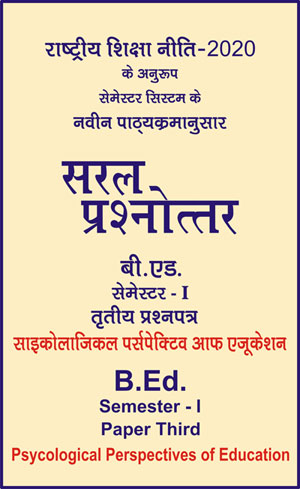|
बी एड - एम एड >> बी.एड. सेमेस्टर-1 प्रश्नपत्र-III - साइकोलाजिकल पर्सपेक्टिव आफ एजूकेशन बी.एड. सेमेस्टर-1 प्रश्नपत्र-III - साइकोलाजिकल पर्सपेक्टिव आफ एजूकेशनसरल प्रश्नोत्तर समूह
|
5 पाठक हैं |
|||||||
बी.एड. सेमेस्टर-1 प्रश्नपत्र-III - साइकोलाजिकल पर्सपेक्टिव आफ एजूकेशन (अंग्रेजी भाषा में)
Question- Discuss Gagne’s theory of learning.
Answer-
Gagne’s Theory of Learning
In 1965, Robert Gagne pointed out that learning can not be explained by simple principles. According to his reasoning generalization regarding the nature of learning is done on the basis of observation of those learning situations. The circumstances in which learning takes place.
According to their assumptions, some pre-requisites have to be determined for normal behaviour as such knowledge level teaching absolutely requires memory, space and training. He defined education as —
| From Simple to Complex |
|---|
| Problem Solving Learning |
| Act Learning |
| Suffix Learning |
| Differentiation Learning |
| Verbal Relation Learning |
| Series Learning |
| Response Stimulus Learning |
| Indicative Learning |
Teaching is the provision of learning situation externally to the student. Stratification is done in the setting of these learning situations. For every learning situation, a pre-condition is necessary for the student, and from this the holding power develops in him.
He gave eight distinctions of learning in his book. In it the condition planning is in a series. For any level of learning to occur in a series or pyramid, it is necessary that all the learning below it has taken place.
The following in the sequence of all the eight types of learning described by them—
(1) Indicative Learning is similar to classical learning contract. The sound of a bell in Pavlov’s classical conditioning experiment and after some time with food the dog has learned to secrete saliva at the mere sound of the bell. This type of learning is an example of sign learning. In this type of learning habits are formed mechanically.
(2) In Response Stimulus Learning in which the animal performs such an action in response to a stimulus. Whose result would have been pleasant to him and gradually he learns to do the same response to the stimulus. Learning is also called S – R learning or operant conditioning.
(3) Series Learning is an adjustment between different stimuli of response. This type of learning is found in muscular learning.
(4) Verbal Assistant Learning is the acquisition of lateral chain like memorizing poetry, learning vocabulary, remembering stories.
(5) In Differentiation Learning the individual learns to make different responses to the stimulus. For example, children learning the difference between a triangle and quadrilateral can equate this learning to Gestalt learning to some extent.
(6) Concept Learning : Learning of a particular meaning on the basis of similar learning of many objects is called conceptual learning. For ex. – in word like bear, Jackal etc. there is a common quality i.e. the concept of a wild animal. This is an example of the concept learning of a wild animal.
(7) Act Learning is based on conceptual learning. In rule learning, ideas are organized by children. In this type of learning, a series of two or more concepts is formed. As the gravitational force of the earth develops the knowledge base of the person through such learning as children learn maths, science.
(8) In Problem Solving Learning, the person solves a problem using a rule and learns the fact in it. Thus problem solving learning is a natural extension of rule learning. This learning lies the content of reflection.
|
|||||














